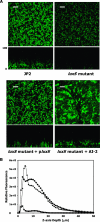Autoinducer 2 is required for biofilm growth of Aggregatibacter (Actinobacillus) actinomycetemcomitans
- PMID: 17591788
- PMCID: PMC1951166
- DOI: 10.1128/IAI.00402-07
Autoinducer 2 is required for biofilm growth of Aggregatibacter (Actinobacillus) actinomycetemcomitans
Abstract
Autoinducer 2 (AI-2) is required for the growth of Aggregatibacter (Actinobacillus) actinomycetemcomitans in culture under conditions of iron limitation. However, in vivo this organism thrives in a complex multispecies biofilm that forms in the human oral cavity. In this report, we show that adherent growth of A. actinomycetemcomitans on a saliva-coated surface, but not planktonic growth under iron-replete conditions, is defective in a LuxS-deficient background. Biofilm growth of the luxS mutant exhibited lower total biomass and lower biofilm depth than those for the wild-type strain. Normal biofilm growth of the luxS mutant was restored genetically by introduction of a functional copy of luxS and biochemically by addition of partially purified AI-2. Furthermore, introduction of S-adenosylhomocysteine hydrolase, which restores the metabolism of S-adenosylmethionine in the absence of LuxS, into A. actinomycetemcomitans did not complement the luxS mutation unless AI-2 was added in trans. This suggests that AI-2 itself is required for biofilm growth by A. actinomycetemcomitans. A biofilm growth deficiency similar to that of the LuxS-deficient strain was also observed when a gene encoding the AI-2-interacting protein RbsB or LsrB was inactivated. Biofilm formation by A. actinomycetemcomitans was virtually eliminated upon inactivation of both rbsB and lsrB. In addition, biofilm growth by wild-type A. actinomycetemcomitans was reduced in the presence of ribose, which competes with AI-2 for binding to RbsB. These results suggest that RbsB and LsrB function as AI-2 receptors in A. actinomycetemcomitans and that the development of A. actinomycetemcomitans biofilms requires AI-2.
Figures



Similar articles
-
The Actinobacillus actinomycetemcomitans ribose binding protein RbsB interacts with cognate and heterologous autoinducer 2 signals.Infect Immun. 2006 Jul;74(7):4021-9. doi: 10.1128/IAI.01741-05. Infect Immun. 2006. PMID: 16790775 Free PMC article.
-
Analysis on Actinobacillus pleuropneumoniae LuxS regulated genes reveals pleiotropic roles of LuxS/AI-2 on biofilm formation, adhesion ability and iron metabolism.Microb Pathog. 2011 Jun;50(6):293-302. doi: 10.1016/j.micpath.2011.02.002. Epub 2011 Feb 12. Microb Pathog. 2011. PMID: 21320583
-
Intra- and interspecies regulation of gene expression by Actinobacillus actinomycetemcomitans LuxS.Infect Immun. 2001 Dec;69(12):7625-34. doi: 10.1128/IAI.69.12.7625-7634.2001. Infect Immun. 2001. PMID: 11705942 Free PMC article.
-
Functional diversity of AI-2/LuxS system in lactic acid bacteria: Impacts on biofilm formation and environmental resilience.Res Microbiol. 2025 Jul-Aug;176(5-6):104296. doi: 10.1016/j.resmic.2025.104296. Epub 2025 Mar 22. Res Microbiol. 2025. PMID: 40122434 Review.
-
[Molecular genetic analysis for oral biofilm formation].Nihon Saikingaku Zasshi. 2007 May;62(2):263-9. doi: 10.3412/jsb.62.263. Nihon Saikingaku Zasshi. 2007. PMID: 17575793 Review. Japanese. No abstract available.
Cited by
-
Lack of genomic evidence of AI-2 receptors suggests a non-quorum sensing role for luxS in most bacteria.BMC Microbiol. 2008 Sep 20;8:154. doi: 10.1186/1471-2180-8-154. BMC Microbiol. 2008. PMID: 18803868 Free PMC article.
-
Intercellular communications in multispecies oral microbial communities.Front Microbiol. 2014 Jul 1;5:328. doi: 10.3389/fmicb.2014.00328. eCollection 2014. Front Microbiol. 2014. PMID: 25071741 Free PMC article. Review.
-
Insights on Escherichia coli biofilm formation and inhibition from whole-transcriptome profiling.Environ Microbiol. 2009 Jan;11(1):1-15. doi: 10.1111/j.1462-2920.2008.01768.x. Environ Microbiol. 2009. PMID: 19125816 Free PMC article. Review.
-
Effects of Luteolin on Biofilm of Trueperella pyogenes and Its Therapeutic Effect on Rat Endometritis.Int J Mol Sci. 2022 Nov 21;23(22):14451. doi: 10.3390/ijms232214451. Int J Mol Sci. 2022. PMID: 36430929 Free PMC article.
-
Autoinducer-2 influences interactions amongst pioneer colonizing streptococci in oral biofilms.Microbiology (Reading). 2012 Jul;158(Pt 7):1783-1795. doi: 10.1099/mic.0.057182-0. Epub 2012 Apr 5. Microbiology (Reading). 2012. PMID: 22493304 Free PMC article.
References
-
- Bassler, B. L. 2002. Small talk: cell-to-cell communication in bacteria. Cell 109:421-424. - PubMed
-
- Bassler, B. L., M. Wright, R. E. Showalter, and M. R. Silverman. 1993. Intercellular signalling in Vibrio harveyi: sequence and function of genes regulating expression of luminescence. Mol. Microbiol. 9:773-786. - PubMed
-
- Bassler, B. L., M. Wright, and M. R. Silverman. 1994. Multiple signalling systems controlling expression of luminescence in Vibrio harveyi: sequence and function of genes encoding a second sensory pathway. Mol. Microbiol. 13:273-286. - PubMed
-
- Block, P. J., A. C. Fox, C. Yoran, and A. J. Kaltman. 1973. Actinobacillus actinomycetemcomitans endocarditis: report of a case and review of the literature. Am. J. Med. Sci. 266:387-392. - PubMed
Publication types
MeSH terms
Substances
Grants and funding
LinkOut - more resources
Full Text Sources
Other Literature Sources

